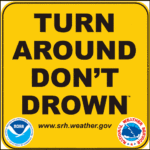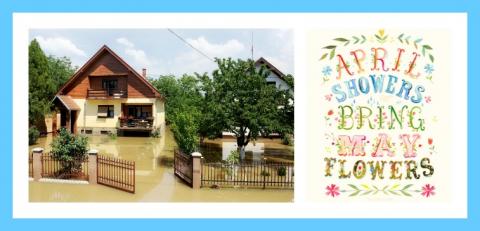April has arrived and now that all the jokes are over, its time to turn our attention to something not so funny—flooding. The saying goes, “April showers bring May flowers,” however sometimes “April showers” can lead to serious flooding issues that may bring damage upon your home or property. According to the National Oceanic and Atmospheric Administration (NOAA), “on average, flooding causes more property damage in the United States than any other weather related event. It is a threat to life and property that can occur in any of the fifty states or U.S territories at any time of the year.” It is extremely important for both homeowners and businesses to not only be properly insured but also be aware of the serious risks that can accompany great flooding.
TERMS TO KNOW:
- Flood watch = Indicates there is potential for flooding to occur and one should stay alert.
- Flood Advisory = Normally issued for urban and small stream flooding. Flooding that is occurring or expected to occur is not predicted to be a threat to your property.
- Flood warning = Flooding is about to happen or has already happened. This type of warning is typically issued within hours of rainfall.
HOW TO BE PREPARED:
- Stay Alert
- Always check the weather reports and be aware if there are any predictions for heavy rainfall that could lead to flooding in your area.
- Be Insured
- Install a Sump Pump
- Sump pumps are placed in a hole in the lowest area of your basement or crawl space to sit and pump out water. As the hole fills with water, it is pumped out through pipes that run away from your homes foundation towards an area where it can drain properly. Sump pumps are a great way to prevent your basement from flooding during heavy rainfall. For more information on sump pumps, click here.
- Create a Flood Evacuation Plan
- Indoors
- Have a battery operated radio or television to stay informed of the flood conditions
- Make sure you have a battery operated flashlight in case power goes out
- Relocate any and all valuables to high grounds to prevent any damage
- Outdoors
- Get to high grounds!
- DO NOT walk through floodwaters. According to the NOAA, it only takes about six inches of water to sweep a person off his or her feet and the water is much stronger than one may imagine.
- DO NOT drive through any flooded waters. The NOAA affirms that “twelve inches of water can float a car or small SUV and 18 inches of water can carry away large vehicles.” The NOAA also states that half of the total freshwater flood-related deaths each year result from motorists driving into flooded waters.
- Indoors







